|
|
Star Shoot

|
|
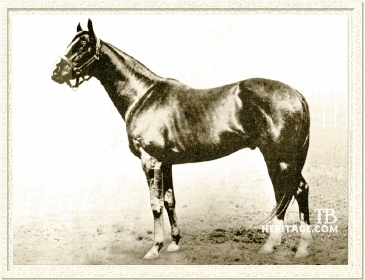 |
|
|
Star Shoot was a living embodiment of the maxim that something one man discards often becomes another man's treasure. Unwanted by his original owner as a stallion prospect because he had developed an undesirable wind infirmity, Star Shoot became worth his weight in gold as a leading sire for the people who next possessed him.
|
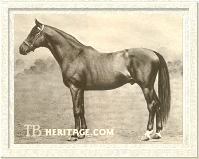
Isinglass as an older stallion
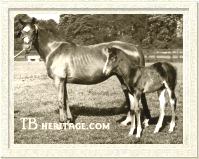
Astrology, in Chaplin's stud
| |
Star Shoot was foaled in Ireland in the spring of 1898 at the Eyrefield Lodge Stud of Major Eustace Loder, later famed as the breeder of the fabulous mare Pretty Polly. A startlingly beautiful chestnut colt with a blaze and two white hind stockings, Star Shoot was sired by Triple Crown hero Isinglass, and was out of Astrology, by Hermit.
Star Shoot was a member of the second crop of Isinglass, son of the great cup performer of the 1870s, Isonomy, and the Wenlock mare Deadlock. Isinglass, racing for his breeder Harry (later Col.) McCalmont, captured the Triple Crown consisting of the Two Thousand Guineas, Derby, and St. Leger, as well as the Eclipse Stakes and the Ascot Gold Cup during a career in which he was defeated once. In his owner's Cheveley Park Stud, at a fee of 200 guineas, he was naturally a popular stallion from the start of his stud career. Isinglass sired three classic winners, and his classics-placed son John o' Gaunt went on to become an important link in the continuation of the Isonomy male line via his son Swynford and grandson Blandford.
Among the mares sent to visit Isinglass was Astrology. She was bred by Henry (later Viscount) Chaplin, the owner of Hermit, and was out of Stella, by a brother to Strafford out of a Toxophilite mare whose dam was Maid of Masham.
|
The pedigree of Astrology on her dam's side was considered weak, and to that point had not yielded a decent stallion prospect, a fact which would affect the future siring career of her son. But Hermit had proven himself a tremendous broodmare sire and his daughters were highly valued as breeding prospects, and Astrology, in fact, became the founder of a female line that produced the French crack and leading sire Astérus; the modest, but successful, Pappageno II; Fastnet; and Prince Chevalier, also a leading sire in France.
Astrology herself had only mediocre ability, racing only at two in 1889 with a third in the Molyneux Stakes her only placing. Major Loder purchased her for 450 guineas, thus adding a coveted Hermit daughter to his broodmare band. During her career at stud, Astrology produced 14 foals. She died in 1910 at the age of 23. Star Shoot was her best offspring, but she also produced the minor stakes winner Telescope and a full sister to Star Shoot named L'Etoile, who failed to win but became the dam of the crack French runner Ecouen. Astrology's daughter St. Celestra, foaled a year before Star Shoot, became the dam of St. Astra, winner in France of the classic Prix de Diane.
Star Shoot contracted a virus shortly after being foaled from which he nearly died. Only the devoted care of the Eyrefield stud groom, "Eyrefield Dan" McNally, saved the colt. One day Loder stopped to check on the sick foal and left convinced that the colt would soon die. When he returned later in the afternoon, McNally had wrapped the tiny foal in blankets in the tack room and laid him in front of a huge fire, while the rest of the stable lads sat listening to McNally tell seemingly endless entertaining stories. Star Shoot recovered, and as a two-year-old, stamped himself as a colt of high promise.
Star Shoot on the Turf
Star Shoot, under the guidance of trainer John Huggins (trainer of Derby winner Volodyovski and Oaks winner Sibola), made his debut in the Summer Breeders' Foal Plate at Manchester on June 6, 1900. Despite his inexperience, he finished a length second to the multiple stakes-winning filly Princess Melton. Eight days later at Ascot, Star Shoot was third to Bay Melton in the New Stakes. The Orme colt Orchid was second. Nine days later, on June 23, at Sandown Park, Star Shoot scored his first victory in the British Dominion Two-Year-Old Plate. A week later, Star Shoot toted 134 pounds, including jockey Johnny Reiff, to victory in the Hurst Park Foal Plate. Arc Royal was second and the Isinglass filly Glasalt, destined to make a mark as an important broodmare, was third.
Star Shoot was then rested until the latter part of July, when he was sent after the National Breeders' Produce Stakes at Sandown Park. Under jockey Reiff, Star Shoot carried 135 pounds, and he finished in a dead-heat with the St. Serf colt Ian, carrying 126 pounds. Bay Melton was third. Among the unplaced runners was a filly by Isinglass named Santa Brigida--also destined to become an important broodmare.
Following this effort, Star Shoot lost his form, for he failed to win again. In his next start, at Derby, he was unplaced in the Champion Breeders Biennial Foal Stakes, the winner being a full sister to John o' Gaunt named Sagitta. Star Shoot was then third to Orchid in the Champagne Stakes and third in Newmarket's prestigious Middle Park Plate, a head and neck behind Floriform and Orchid.
During the winter, Star Shoot became affected in his breathing. Classic engagements were abandoned and he did not start until the summer. Star Shoot raced twice -- in the Triennial Stakes at Ascot and the Midsummer Derby at Newmarket -- and was unplaced both times.
Star Shoot in the Stud
Star Shoot was retired from the turf with a record of three wins (one dead-heat), one second, three thirds, and three unplaced finishes in ten lifetime starts. He might have made a desirable stallion prospect for British breeders, as he was classically bred and had been a precocious juvenile. But the British had no desire to breed to a horse with affected wind -- the memory of Ormonde, sold and sent to Argentina for stud duty because his owner did not wish to pass his wind infirmity on to succeeding generations -- served as a reminder. Star Shoot also developed a problem with soft feet. Ironically, it was the tender feet, not the wind infirmity, which Star Shoot passed on to many of his progeny.
Then there was Bruce Lowe, the pedigree expert who had recently started a numbering system for the various Thoroughbred families. According to his wisdom, Star Shoot was a member of the number 9 family, which, it was flatly stated, was not able to produce a decent stallion. The young stallion Cyllene, also descended in the female line from Maid of Masham, suffered from much the same prejudice. Even after siring two winners of the Epsom Derby, Cyllene was exported to Argentina, leaving a further two Derby winners behind in England and going on to become a leading sire in his adopted country. So, too, Star Shoot was exported. And as in the case of Cyllene, the adoptive country had the last laugh, for just like Cyllene, Star Shoot became a successful sire.
In 1901, under the care of a man named John Hanning, Star Shoot was shipped to the United States where he stood at stud under the ownership of Messrs. Clay and Woodford, partners in the Runnymede Farm near Paris, Kentucky. He remained at Runnymede until November of 1912, when he was sold to John E. Madden and moved to Hamburg Place, near Lexington. Star Shoot served his first season in 1902, and was a success from the time his first runners hit the track. In 1908, he was among the top 20 leading American sires, and was never out of the top 20 through 1923. Star Shoot led the American sire list in 1911 and 1912, 1916 and 1917, and 1919. He was second in 1914, 1915, and 1921, and third in 1913 and 1918. Once he was fourth and twice he was fifth. Star Shoot was consistently among the top two-year-old sires. Star Shoot got top runners from all kinds of mares, whether they were of high racing class or mares of mediocre credentials.
At Runnymede, Star Shoot averaged just 28 foals per crop. Once he moved to Madden's Hamburg Place, he was kept much busier. In just his first season at Hamburg, Star Shoot was bred to 90 mares and got 52 in foal. Of these, 36 turned out to be winners, 27 of them were two-year-old winners, and 11 of them were stakes winners--all records at the time for a single crop. All told during his stud career, Star Shoot sired 61 stakes winners--34 of those bred by Madden.
One of the earliest top class representatives of Star Shoot was the filly WING TING, foaled in 1904. The dam, Van-A-Clar, was by the Billet stallion Barnes out of Clipsa, by Belmont Stakes winner and champion Springbok. The third dam was by the Orlando stallion Eclipse. Wing Ting captured the Kentucky Oaks. As a broodmare, she was second dam of Washington Park Handicap winner Isaiah and of Rolled Stocking, winner of the Latonia Championship Stakes and second place finisher in the Latonia Cup. Wing Ting was third dam of the Chance Play horse Invader, winner of the Saratoga Steeplechase and twice winner of the Broad Hollow Steeplechase.
One of the members of the Runnymede broodmare band was Kentucky Belle, a full sister to the champion racehorse and leading sire Hanover. She was mated with Star Shoot at least four times, producing four colts. The best of their offspring was KENTUCKY BEAU, winner of the Champagne Stakes, Dixiana Stakes, Waldorf Stakes, and Prospect Handicap. Unfortunately, Kentucky Beau had been gelded. One of his full brothers was also gelded, and the remaining brothers achieved no lasting fame.
The mare Lizzie Dixon (by Sir Dixon) and her mother, Catalina (by Hindoo), both Runnymede mares, each foaled daughters to the cover of Star Shoot. Lizzie Dixon's Star Shoot daughter was the stakes winner LILLIE TURNER, winner of the Latonia Oaks. Catalina's Star Shoot daughter was STAR CAT, destined to become the dam of Puss In Boots, a Peter Pan colt which won the Grand Union Hotel Stakes, and of the good racefilly Star Jasmine, victress over males in the Latonia Cup and Champlain Handicap. Star Cat was second dam of Latonia Derby winner Gold Basis and steeplechase stakes winner Prowler.
STAR CHARTER was an intensely inbred individual on his dam's side. He was out of the mare Charter Queen, a daughter of Sir Dixon and his own half sister Magna Carta. Both Sir Dixon and Magna Carta were out of the mare Jaconet, a full sister to Iroquois. Star Charter was a tough campaigner, winning the Clark Handicap and Latonia Cup at three and the Frontier Handicap in Detroit at four. He was the nation's leading money-winner at three considered the best handicap performer of 1912. Star Charter sired no recorded foals.
One of the last top class horses sired by Star Shoot during his tenure at Runnymede Farm was ADDIE M., whose dam, the Hindoo mare Breakwater, had previously produced Alabama Stakes winner Running Water. Like her half sister, Addie M. also captured the Alabama Stakes. She was not a successful broodmare, but her year-younger full sister, Christmas Star, became an important producer for Walter M. Jeffords.
|
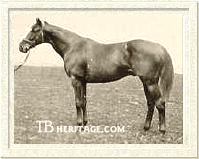
Sir Barton
| |
The most famous of Star Shoot's progeny was the chestnut colt, SIR BARTON, first winner of the American Triple Crown. Bred by John Madden and foaled at Hamburg Place in 1916, Sir Barton was out of the Hanover mare Lady Sterling. This mare, like Star Shoot, was a tail-female descendant of Maid of Masham. For Madden she had previously produced the champion colt Sir Martin, and she had a daughter, Lady Doreen, Sir Martin's full sister, who would become the dam of champion filly Princess Doreen. Her son by Star Shoot was a compact chestnut with a blaze, the sensitive feet of his sire and an irascible temperament.
|
Midway through his two-year-old season, Sir Barton was sold to Commander John Kenneth Leveson Ross, whose father, James Ross, had been one of the founders of the Canadian Pacific Railway. Ross paid $10,000 for Sir Barton as a two-year-old. At the time of his purchase, Sir Barton had been out four times and his best finish had been a fifth place in the Tremont Stakes. In two more starts at two, he finished fifteenth in one race and a good second in the Futurity.
At three, Sir Barton was a different animal. He won the Kentucky Derby loose on the lead on a muddy track, captured the Preakness only four days later, then added the Withers prior to scoring by five lengths in the Belmont. That fall, Sir Barton captured the Potomac Handicap, ran third to Cudgel and Exterminator in the Havre de Grace Handicap, beat Mad Hatter in the Maryland Handicap, and won the Pimlico Fall Serial races numbers two and three.
At four, Sir Barton was not as dominant, winning eight of thirteen, but he turned in perhaps his finest lifetime performance, carrying 129 pounds to victory over Exterminator (carrying three pounds less) in the Saratoga Handicap, with Wildair, The Porter, and Mad Hatter making up the rest of the field. A special match race with Man o' War at Kenilworth Park in Canada resulted in Sir Barton being soundly beaten by the younger champion. Interestingly, Sir Barton and Man o' War were each sired by members of the number nine family, Man o' War's sire, Fair Play, also being a female line descendant of Maid of Masham.
At stud, first in Virginia, and then at an army remount station in Wyoming, Sir Barton was a severe disappointment. The best horse he sired was the filly Easter Stockings, winner of the 1928 Kentucky Oaks and Latonia Oaks, and also during her career the Grainger Memorial Handicap and Covington Handicap. Sir Barton's last years were sad, as at first he was used as a teaser by the remount service because he did not meet their minimum sixteen hand height requirement. When that rule was relaxed, he served some mares. He died in Wyoming in 1937, the same year War Admiral, the son of his old nemesis Man o' War, won the Triple Crown. |
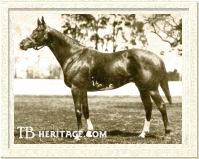
Grey Lag
| |
John Madden said GREY LAG was the best horse he ever bred. Grey Lag, named after a British dialect term for northern European wild geese, was a smashing chestnut colt with a blaze, two white stockings on his right side and a splotch of white on his underside. Grey Lag was of Miss Minnie; she was a daughter of Meddler, champion juvenile colt in England in 1892 and a leading sire in the United States. The dam of Miss Minnie was a daughter of Orvieto from a mare by Derby winner Melton. With such a pedigree, it was disappointing that Miss Minnie was a total failure on the track, placing no higher than third in ten lifetime starts. But Madden wasn't shy about giving horses a chance at stud, whatever their credentials.
|
Madden sold Grey Lag and a filly to trainer Max Hirsch for $10,000. In turn, Hirsch tried to re-sell Grey Lag at a substantial profit to trainer Sam Hildreth, who turned the colt down on superstitious grounds after seeing the patch of white on the horse's belly. But when Grey Lag soon after landed a victory in the Champagne Stakes, oilman Harry F. Sinclair enthusiastically paid $60,000 for the colt--and turned him over to Sam Hildreth to train.
Grey Lag blossomed as a three-year-old. Though injury forced him out of the Kentucky Derby, he later reeled off eight straight victories, including the Belmont Stakes, the Brooklyn Handicap (defeating Exterminator, Mad Hatter, Eternal, John P. Grier, and Paul Jones), the Dwyer Stakes, Empire City Derby, Knickerbocker Handicap (carrying 135 pounds), and the Mount Kisco Stakes. At four, Grey Lag added victories in the Queens County Handicap, Mount Kisco Stakes, Empire City Handicap, and the Saratoga Handicap (giving Prudery sixteen pounds) to his resume. At five, Grey Lag added further to his championship laurels by taking the Kings County Handicap, the Excelsior Handicap, the Metropolitan Handicap (under 133 pounds), and the Suburban Handicap (under 135 pounds).
Sadly, Grey Lag proved an abysmal failure at stud, siring only nineteen named foals. One of these, a filly named Greyola, was a stakes winner. She was a filly of great potential, as she beat the colts, including Jim Dandy, in the Agua Caliente Derby. Tragically, she died on the train while being shipped back east. A mating with champion filly Regret yielded a colt, later gelded, which could not win, and a mating with the multiple stakes producer Blue Glass, later the dam of Unbreakable, resulted in a colt which started over two hundred times for eleven victories and just over $8,100 in career earnings.
After a few years at stud, Grey Lag went completely sterile and was returned to training at ages nine and ten. He won a couple of tiny races, and was retired again. He was then given away to a veterinarian as a riding horse. He did not stop there long, as his new owner soon died, and Grey Lag changed hands several times, finally sinking to the level that, at age thirteen, he was racing in $1,000 claiming company up in Canada. In one of those races, the old champion picked up $40 for finishing third--the last purse money recorded for the progeny of Star Shoot. Harry F. Sinclair, alerted to the situation by newspaper reports, rescued the old horse from his sad plight. Having served prison time for his role in the Teapot Dome oilfield scandal, Sinclair had no desire to have any more negative publicity. He re-purchased Grey Lag and returned him to his former home at Rancocas Farm in New Jersey to live out a peaceful retirement. Grey Lag died at the age of 24 in 1942. Both Grey Lag and Sir Barton represent their sire as members of the National Museum of Racing Hall of Fame in Saratoga Springs, New York.
Star Shoot was the sire of another champion in the filly WISTFUL, winner of the inaugural Coaching Club American Oaks in 1917. She was from Star Shoot's first crop of Hamburg Place-sired runners, mares covered in 1913. The dam, Witfull, was fourteen when she foaled Wistful, and had previously not produced anything of any merit. She was by Mirthful, an American-born son of the English stallion Hagioscope and an indifferent sire. The only thing to recommend Wittful was her female line. Her fifth dam was the celebrated foundation mare Reel, her fourth dam, Fanny Wells, was a half sister to LeComte and Prioress. Her full sister, Responsive, had produced the champion filly Gowell, winner of the Ashland Oaks, Golden Rod Handicap, Latonia Inaugural Handicap, and third place finisher to Donerail in the 1913 Kentucky Derby. Based upon her victory in the Coaching Club American Oaks, Wistful was widely considered the champion filly of her generation. She also ran third in the Gazelle Handicap. As a broodmare, Wistful produced five foals, four of whom were winners, but her branch of the Reel family did not breed on.
Another member of Star Shoot's first Hamburg Place crop was the colt STARGAZER. A son of the Meddler mare Busy Maid, Stargazer was a winner of the Manhattan Handicap.
A mating of Star Shoot with the Himyar mare Ivory Bells yielded the colt IVORY BLACK. Foaled the same year his elder half-brother Old Rosebud won the Kentucky Derby, Ivory Black did not have as an illustrious career. He did win the Keene Memorial Stakes and ran second in the Juvenile Stakes. Sadly, he had no recorded progeny.
A mating with another daughter of Himyar, The Lady In Blue, resulted in Queens County Handicap winner STAR MASTER. He became a fairly useful stallion, his best progeny including Kentucky Oaks second place finisher Rich Widow, Louisiana Derby winner McCarthy, and Queens County Handicap winner Kildare to his credit.
FAIRY WAND was yet another member of Star Shoot's first Hamburg Place crop. She came from an exceptional family. Her second dam was the champion racemare Wanda, dam of two stakes winners, Urania and Glacier. Urania produced three stakes winners, including the dam of Epsom Derby winner Durbar II. Another daughter of Wanda, Countess Wanda, by Loyalist, was the dam of Fairy Wand and her elder stakes-winning half sister, Planutess.
Fairy Wand won 13 races in 60 lifetime starts, her biggest victory coming in the Gazelle Handicap. As a broodmare, she produced two top class runners. Genie, her 1925 colt by Man o' War, won the Dwyer Stakes, Empire City Derby, Bowie Handicap, and Riggs Handicap. He also placed second in the Wood Memorial and second to Vito in the Belmont Stakes. her colt by Epinard, Epithet, was a winner of the Hopeful Stakes.
|
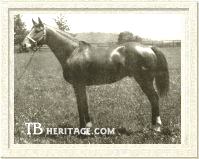
Audacious
| |
AUDACIOUS, foaled in 1916, was a durable handicap performer. Like Wistful, he was descended from Galopade, the dam of Reel. His descent was not as close as that of Wistful, for his ninth dam, Fandango, was a half sister to Reel. More significantly, his third dam, Bandala, was half sister to the sensational racehorse and sire Domino. Broodmare sire of Audacious was Ogden, English-bred winner of the Futurity Stakes and Great Eastern Handicap and as a stallion, champion sire of juveniles in 1914. |
With such speed elements in his pedigree, it was somewhat surprising that Audacious did not reach his peak until he was an older horse. At three, he won the Montagu Handicap, at four the Carter Handicap. He really blossomed as a five-year-old, taking the Carter for a second time, as well as the Pierrepont Handicap and the Suburban Handicap. He also ran second in the Queens County Handicap and Empire City Handicap. At the age of six, Audacious was victorious in the Clark Handicap. Audacious was not a tremendous success at stud, stakes winners Storm and Foolhardy being his best representatives.
Of Star Shoot's remaining stakes winners, some of the most noteworthy include: GEORGIE (out of Fair Atalanta, by Knight of the Thistle), winner of the Interborough Handicap; ARENDAL (out of Pyrope, by Sir Wilfred), winner of the Cadillac Hotel Stakes; GOLD TASSEL (out of Rose of Gold, by Top Gallant), winner of the Tremont Stakes; HILDUR (out of Shelby Belle, by Knight Errant), winner of the Jacques Cartier Handicap; SEA SHELL (out of Flying Ship, by Flying Dutchman), winner of the Hudson Stakes; HELIOS (out of Hindoo Rose, by Hindoo), was a winner of the Cincinnati Trophy and the Breeders' Futurity; and STAR HAMPTON (out of Dorothy Hampton, by Royal Hampton), winner of the Albany Handicap.
The Next Generation
The most important son of Star Shoot as a progenitor was UNCLE. Foaled in 1905, Uncle was a contemporary of Fair Play, Colin, and Celt. Uncle was bred by John E. Madden, who had sent his mare The Niece, a half sister to Belmont Stakes winner and leading sire Sir Dixon, to be covered by Star Shoot. Uncle was a good looking chestnut colt, but was unfortunately plagued by the tender feet which hampered so many of the get of Star Shoot. Consequently, it was hard to gauge his true racing ability. |
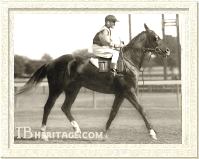
Uncle was Star Shoot's best sire son
Photo Courtesy Keeneland Library.
| |
Madden sold Uncle to trainer Sam Hildreth as a yearling for $30,000. The purchase at first seemed a good one, as shortly after, Uncle got to within a length of the sensational Colin in the Saratoga Special. A few days later, Uncle pulled up lame after a workout. Despite efforts which lasted until the late autumn of 1908 to get him sound, Uncle was retired. He had won seven races in twelve starts. Uncle was a successful stallion: nine times he ranked among the top twenty American sires. The best of his get were champion and Kentucky Derby winner Old Rosebud, Bashford Manor and Blue Grass Stakes winner Step Along, and California Derby winner Victoire. |
Uncle's daughter, Uncle's Lassie, was also a minor stakes winner, but she made a more important mark as a broodmare. She foaled five stakes winners, among them Kentucky Derby winner Clyde Van Dusen (by Man o' War) and Betty Derr (by Sir Gallahad III), winner of the Latonia Oaks and Clipsetta Stakes. As a producer, Betty Derr founded a family which over the years has included classic winners Swaps and Iron Liege, as well as Broodmare of the Year Courtly Dee, dam of eight stakes winners and granddam of numerous others.
Being out of a mare by Hermit, an extraordinary sire of fillies, it was hardly surprising that Star Shoot became a fine sire of broodmares himself. Star Shoot led the American broodmare sire list five times--1924 through 1926 and again in 1928 and 1929. Many of the top class campaigners from Star Shoot mares came from daughters which were either unraced or of little account on the racetrack.
|

Crusader (Man o' War - Star Fancy)
| |

Mars (Man o' War - Christmas Star)
|
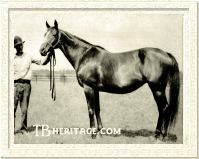
Careful (Wrack - Mindful)
| |
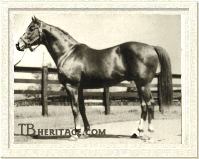
Jack High (John P. Grier - Priscilla)
|
STAR FANCY was an example of one such mare, for her fame came not on the racecourse, but as a producer. She was one of several mares collected by Samuel Riddle as prospective mates for his champion Man o' War. Her family was hard to fault. Her fifth dam was Maggie B.B., dam of Iroquois and Jaconet, she the dam of Sir Dixon and second dam of the aforementioned Uncle. The third dam of Star Fancy, Sallie McLelland had captured the Alabama Stakes, her daughter Audience had taken the Kentucky Oaks and was dam of champion Whisk Broom II. This was also the immediate family of Star Shoot's champion son Star Charter.
Mated with Man o' War, Star Fancy produced steeplechase stakes winner Gun Boat and stakes-placed filly Sister Ship. Her finest, though, was Crusader, a member of Man o' War's second crop, foals of 1923. A strong, handsome individual, Crusader inherited the chestnut coat of his sire and grandsires Star Shoot and Fair Play. Barely useful on the racetrack as a two-year-old, Crusader blossomed at three and four into the best American horse in training. At three, he was victorious nine times in fifteen starts, including the Belmont Stakes, the Suburban Handicap, the Cincinnati Derby, the Dwyer Stakes, the Riggs Handicap, and the Jockey Club Gold Cup. At four, Crusader took a second Suburban Handicap. An injury at the post prior to the running of the Brooklyn Handicap effectively ended his career, as Crusader never recaptured his dominating form. It was a great pity for the breeding world that Crusader proved a severely disappointing stallion, given his resplendent pedigree and brilliant race record. He sired only six stakes winners before his death in California in 1940.
CHRISTMAS STAR was a daughter of Star Shoot who became a member of the Walter Jeffords broodmare band, and like Star Fancy, she was selected as a mate for Man o' War. Her dam, Breakwater, by Hindoo, had previously produced two winners of the Alabama Stakes, Running Water (by Sir Dixon) and the aforementioned Addie M., by Star Shoot. The next three dams--Ricochet, Erycina, and Atalanta--were all New Zealand-bred, the former being a stakes winner in her country prior to her importation to the United States and the latter two being New Zealand stakes producers.
Prior to being acquired for Man o' War's harem, Christmas Star had produced the good Broomstick colt Escoba, winner at two of the Bashford Manor Stakes, Idle Hour Stakes, and Breeders' Futurity, and second in the Sanford Memorial Stakes. At three, Escoba ran second to Exterminator in the Kentucky Derby.
For Jeffords, the best offspring Christmas Star produced was the Man o' War colt Mars. During his racing career, Mars captured the Travers Stakes, Saratoga Handicap, Dixie Handicap, two divisions of the Pimlico Weight-For-Age Serial Handicap, the Saranac Handicap, the Washington Handicap, Walden Handicap, and Junior Champion Stakes. He was also third to Display in the Preakness Stakes. Sadly, like Crusader, Mars proved a failure at stud, getting barely a handful of minor stakes winners from only 87 recorded foals. Mars lived a long life, dying peacefully at Faraway Farm in 1949 at the age of 26. Christmas Star also produced a half-sister to Mars named Guiding Star who placed second in the Acorn Stakes.
The Finn was a champion grandson of Star Shoot foaled in 1912. Bred by John Madden, he was by Ogden from Star Shoot's daughter LIVONIA. A winner of the Great Eastern Handicap and the Willow Handicap, Livonia came from an exceptional classic-producing family. Her dam, Woodray, was out of a half-sister to Belmont Stakes winner Forester. Livonia's third dam, Woodbine, was a winner of the Alabama Stakes and a half-sister to the dam of 1883 Preakness winner Jacobus. Kentucky Derby winner Wintergreen and Kentucky Oaks winner White Frost also hailed from this family. The Finn was an impressive black colt who was among the best horses in training in the United States in the years 1915 through 1917 and at stud was leading sire in the U.S. in 1923, two years before his premature death at the age of thirteen.
Champion filly Careful was one of the first champions bred by Arthur Boyd Hancock at Claiborne Farm near Paris, Kentucky. He had a Star Shoot dam named MINDFUL. She was out of a daughter of Hindoo named Merdin, and had been bred by Catesby and Woodford. The sixth dam of Mindful was a half-sister to famed mare Reel named Cotillion. This branch of the family had produced stakes winners Gold Heels, Los Angeles, and Glidelia. Merdin was a half-sister to Futurity Stakes winner The Butterflies and to Kentucky Derby runner-up Runnymede. Hancock mated his beautifully-bred Star Shoot mare to his imported stallion Wrack, a grandson of dual English classic champion Ayrshire.
The resultant filly, named Careful, was sold to Walter P. Salmon, and in his colors won two championships. She was named champion two-year-old filly of 1920 by virtue of eight stakes victories, including the Schuylerville Stakes, Clover Stakes, Pimlico Nursery, and National Stakes. At three, she won the Chesapeake Stakes and Laurel Handicap. At four, Careful was named champion handicap mare with a victory in the Fall Highweight Handicap, and second place finishes in the Metropolitan Handicap, Carter Handicap, and a third place finish in a Pimlico Serial Weight-for-Age race. As a broodmare, Careful was somewhat disappointing, but she was second dam of the good handicapper Lochinvar and third dam of champion Dedicate.
Hancock also bred the tough campaigner Blazes. Like Careful, he was sired by Wrack and was out of Star Shoot's daughter BLAZING STAR. This mare came from the Jaconet branch of Maggie B.B.'s family, her dam, the Spendthrift mare Alarm Belle, being a half-sister to Uncle. Blazes had the misfortune to come along in the same crop as Man o' War, but even so, he managed to win his share of important races. Blazes won the Breeders' Futurity, the Laurel Handicap over The Porter and Sir Barton, the Maryland Handicap over Damask and John P. Grier, and the Excelsior and Harford Handicaps over Exterminator. At stud, Blazes sired a few stakes winners, but nothing approaching his own class.
MALLARD was a fine producing daughter of Star Shoot, for she was the dam of two top class racetrack performers. And she too hailed from the family of Maggie B.B. and her daughter Jaconet. Star Shoot seemed to have achieved very satisfactory results when crossed with this family of mares. As a broodmare for John E. Madden, she produced Captain Alcock to the cover of Ogden and Rockminister to the cover of Friar Rock. The former captured such races as the Suburban Handicap, Pimlico Cup, Brooklyn Handicap, and Bowie Handicap. The latter took the Huron Handicap, Latonia Championship, and the Pimlico Cup. Alas, neither were successful, both siring very minor stakes winners and each siring steeplechase stakes winners.
PRISCILLA, out of Yankee Sister, by Yankee, was a winning daughter of Star Shoot. She hailed from a classic English family--that of Seclusion, dam of Hermit and founder of a female family which had included English classic winners Elizabeth and Minoru and Italian Classic winner Volador before Priscilla was even foaled. Her best offspring was the John P. Grier colt Jack High, winner at two, in 1928, of the Hopeful Stakes, Flash Stakes, and Tremont Stakes, and winner at four of the Metropolitan Handicap. During his long racing career (Jack High raced through the age of six), he also earned placings in such fixtures as the United States Hotel Stakes, Saratoga Special, Futurity Stakes, Brooklyn Handicap, Withers Stakes, Belmont Stakes, Carter Handicap, and Manhattan Handicap. At stud, Jack High sired champion filly High Fleet, as well as Knave High, Jacomar, and Noodle Soup, dam of Kentucky Derby and Belmont Stakes winner Needles. Priscilla also produced a full sister to Jack High named Straightlace, winner of the Demoiselle Stakes.
Perhaps the daughter of Star Shoot who was the best broodmare was DAYLIGHT SAVING, dam of four stakes winners. Daylight Saving was out of Tea Enough, by Ogden out of Tea's Over, by Hanover. Tea Enough was a half-sister to stakes winners Dick Welles and Ort Welles, and to Tea Biscuit, later the dam of Seabiscuit's sire Hard Tack. The family would later include classic winner Jamestown.
The first stakes winner out of Daylight Savings was Recreation, by Spanish Prince II. This filly was a winner of the Empire City Handicap and placed second in the Demoiselle Stakes and another running of the Empire City Handicap. She was also third in five stakes races, including the Alabama Stakes. She was not a success as a broodmare.
The next stakes winner for Daylight Saving was the filly One Hour, by Snob II. Her wins included the Adirindack Stakes, Astoria Stakes, and the Beldame Handicap. She was second in the Matron Stakes and the Pimlico Fall Serial Weight-for Age race number 1, and third in the Demoiselle Stakes. As a broodmare, One Hour produced Kentucky Derby winner Hoop Jr., Lawrence Realization winner Magic Hour, and stakes-placed runners Gay Monarch and Morning. Daylight Savings was third dam of stakes winner Count Flame, Favorito, and Good Morning, fourth dam of Battle Morn,Victory Morn, and Politely.
Clock Tower, a full brother to One Hour, was a winner of the Washington Handicap and the Maryland Handicap, was second in the Wood Memorial, and third in the Withers Stakes and Riggs Memorial. His best offspring was the filly Dawn Play, victress in the Coaching Club American Oaks, Acorn Stakes, and American Derby.
When Daylight Saving was mated to American Flag, she came up with the brothers Gusto and Union. The former was victorious in the American Derby, Classic Stakes, and Jockey Club Gold Cup, and Union placed third in the Belmont Stakes. Neither of these sons did anything as sires.
THUNDERBIRD was the daughter of Star Shoot who holds the honor of being the dam of a son whose name has been familiar to American racegoers since 1930. Out of Grace G., by Albert, the family of Thunderbird was nothing special, producing only minor winners back several generations. Thunderbird herself was a winner of just five races in over seventy starts. But even mediocre Star Shoot fillies were sought after for someone's broodmare band, so Thunderbird got her chance. Mated with the useful stallion Jim Gaffney, she foaled the colt Jim Dandy, winner at two of the Grand Union Hotel Stakes and at three of the Travers Stakes. In the latter race, Jim Dandy, at 100-1 odds, took the measure of Triple Crown champion Gallant Fox. This shocking victory earned Jim Dandy notoriety at the time, almost on a par with Upset's defeat of Man o' War. But later, Jim Dandy's victory garnered him remembrance with a race named in his honor. Run every year since 1964 at Saratoga as a prep for the Travers, the Jim Dandy has been won by the likes of such superior runners as Arts and Letters, Personality, Affirmed, Private Account, and Conquistador Cielo.
Other notable producing daughters of Star Shoot include: FOX TROT (out of Passan, a Hamburg half-sister to unbeaten champion Colin). Fox Trot's daughter by Celt, Toddle, became an important mare for Walter Salmon's Mereworth Farm, foaling the crack stakes winning filly Swivel, Sanford Stakes winner Mad Pursuit, and Preakness Stakes winner Dr. Freeland; BRIGHT START (out of Quality, by Hindoo), dam of Falls City and Camden Handicap winner Guest of Honor; STAR OF DANUBE (out of Blue Danube, by Hindoo, a granddaughter of Maggie B.B.), dam of Registrar, (by Friar Rock), winner of the First International Handicap among other stakes performances; MAUD B.L. (out of Queen Dixon, by Sir Dixon), dam of multiple steeplechase stakes winner Thorndale; HYPATIA (out of My Queen, by Hindoo), dam of Demoiselle Stakes winner Ethereal; GALAXY ( out of reflex, by Sir Dixon), dam of Kentucky Jockey Club Stakes winner Desert Light; MILKY WAY (out of Olga Nethersole, by Hindoo, third dam a full sister to Bramble), dam of stakes winner War Plane, (by American Flag) and stakes-placed War, (by Man o' War); SKY ROCKET (out of Maribel, by Hindoo), dam of Canadian stakes-winning brother and sister Pin Wheel (Coronation Stakes) and Push Pin (Kenilworth Handicap); MARIE ODILE (out of Colline, by Hanover), dam of Tremont Stakes winner Draconis, (by North Star III); STAR CLASS (out of Lady Bedford, by Ogden, second dam a half-sister to Uncle), dam of Preeminent (by Supremus), winner of several stakes, including the Fall Highweight Handicap and Toboggan Handicap. Star Class was also the dam of dual stakes-winning filly McAuliffe (by Spanish Prince II); SWEET BRIER (a full sister to Star Class), was the dam of the good Playfellow filly Ben Machree, winner of both the Latonia Oaks and Latonia Cup; MUTTIKINS (out of Falcon, by Ogden). A stakes winner herself, she produced the colt Spearhead, winner in Canada of the Prince of Wales Plate and the Coronation Stakes; and THE COLONEL's LADY (out of Elmaha, by Ogden, sixth dam Maggie B.B.), became the dam of Court Scandal (by Royal Minstrel), winner of the Youthful Stakes and Flamingo Stakes.
Based upon his record as both a sire and a broodmare sire, it can be said that Star Shoot was one of the most important American sires of his era. It was a severe disappointment that his male line did not breed on. Thirty-three of Star Shoot's sons entered the stallion ranks, yet only Uncle made a significant impact as a sire. Sadly, the best son of Uncle, Old Rosebud, was a gelding. This unfortunate dearth of successful siring sons effectively spelled the death knell for the Isonomy male line in the United States. After Star Shoot, the best representatives were Blenheim II and his son Mahmoud, and they too failed to leave a son capable of carrying on the line in this country. But at least the wealth of his daughters have made sure that Star Shoot's name did not become extinct in succeeding generations of American pedigrees.
Star Shoot had cheated death when so critically ill as a foal in Ireland. But on November 19, 1919, shortly after noon, the great stallion failed to keep death at bay a second time, and succumbed to pneumonia. He was 22, and but for his final illness and death, he might have enjoyed some more seasons at stud. Madden laid his mighty stallion to rest in Hamburg Place's picturesque little equine cemetery off Winchester Road near Lexington.
-- Liz Martiniak
|
|
|
|

